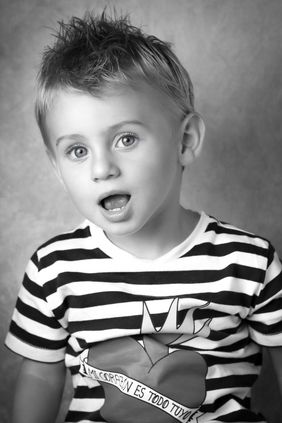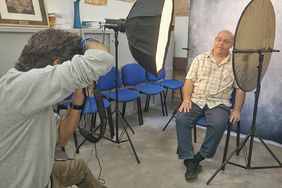Xavi Josa
Turning the camera on themselves

What makes a perfect image and why do photographers create the images that they do? As Fujifilm Original Photo Paper we have a natural link with photography. The passion and vision of photographers tells a beautiful story, especially in print. We ask Xavi Josa to tell his story…
Who is… Xavi Josa?
I am a freelance graphic designer and photographer born in the Gracia neighbourhood of Barcelona on 11 May 1969.
I believe I am an intimate photographer who through the viewfinder of my camera, tries to show my personal perspective of that which surrounds me. I am passionate about portraits and I simply must find the true essence of people through their eyes.
Please tell us about your professional career.
It started through product commercial photography mainly in the wine sector when I took photographs for wineries of wines, sparkling wines and cavas.
And also other product photography work such as jewellery items and photographs for corporate websites.
This evolved to social photography for councils and, in 2018, an exhibition: “70 Miradas en Democracia” (70 Perspectives in Democracy).
This involved 70 portraits of elderly people from Sant Quirze del Vallès in honour of the Elderly People of the village. A project in which the Council itself collaborated.
In 2019, I was involved in a personal project of 49 portraits of people who were suffering from unusual diseases for the Marató de TV3 (TV3 Marathon) project with the charity objective of visualising unusual diseases and collaborating with the TV3 Fundación de la Marató (Marathon Foundation) to collect donations in order to research diseases.
The following collaborated in the project: FECAMM (Federació Catalana de Malalties Minoritàries; Catalan Unusual Diseases Foundation) and Fujifilm that supplied everything that was technical such as the photographic equipment, printing and photographic finishes where they used their new Maxima professional photographic paper.
There has been a main exhibition with the 49 black-and-white photographs measuring 75 by 50 cm and various parallel travelling exhibitions that showed 15 photographs with the same characteristics as the main exhibition.
What inspired you to concentrate on the photographic business sector?
Well, since photography is an art form, it is always inside of you. Down the years, you may learn or refine certain techniques, but you always have that artistic component that is enshrined in you. I believe this is the essential and necessary ingredient in order to be a good photographer.
What are you the most passionate about?
To start, the simple act of having a camera in my hands already makes me passionate, we could even say that it is the object which makes me truly comfortable and naturally being able to look through the viewfinder and catch and steal those instances that will never be repeated. I am passionate about the intimate contact when I take portraits. The personal challenge to get the indispensable connection between the model and the photographer. Improvising during my sessions is also one of my passions.
Let’s talk about the Marató de TV3 exhibition. Where did the idea come from?
It is a personal project that arose from my heart. I felt that I could give a voice and light to that social collective of ill people through my photography and show to society the reality of having an unusual disease and, on the other hand, contribute my grain of sand through donations based on the exhibition.
The project started in July 2019 after having first talked to Marató de TV3 and later to FECAMM when I presented the idea of having this charity project.
As from the very beginning, there was the clear idea that they had to be very intimate and personal portraits in black and white with a slight colour nuance if this was possible, small details that sometimes could not even be noticed, but always present, that strengthened the personality of each of them.
In the 49 produced photographs, there is a mix of ages and genders in order to give the most global vision possible of the effect of the diseases.
I started the initial photographic sessions at the beginning of August and they came to an end of November. All the sessions took place where the volunteers lived who were affected by some disease and throughout the Catalan region.
Let’s comment on the role that Fujifilm plays in this collaboration.
Basically, it was a crucial role. Without its collaboration, the project would not have happened. In projects of this size that involve many photographs and a complex infrastructure, you either have a powerful “partner” that can contribute with the required technical media and materials or they can be difficult to achieve based solely on your own initiatives. Unfortunately, most artists like me need a “patron” in order to complete projects of this scale.
How has digitisation impacted photography as a business?
Well, with regard to printing, I would have to say badly. The change from analogue to digital has meant that there may have been a standstill. People are not printing or developing as they used to. The obsession, in particular, of most of our new photographers who were born in the digital era of accumulating thousands of photographs on their hard drives that will possibly never leave their screens or the digital format.
On the other hand, we have the issue of everybody considering themselves a photographer due to, for example, digitisation and the ever greater number of smartphones. The market is now saturated and some jobs that were previously only done by those who really devoted their art and knowledge has changed. Now anybody believes they can do it. Obviously, later we have the surprises and frustrations!!
However, to be positive, the digitisation of photography has now made us faster, more agile, we get more for our money and we can rely on a technical and logistical support that is much more powerful and efficient than before.
What do you like the most about Fujifilm? The cameras, the paper, the way they treat you, the technical service, …
I usually worked with other brands. For this project, I suggested we use only Fujifilm photographic equipment. I was sure that this was the only way. Close the circle of shooting with a Fujinon camera and mount lenses and, of course, the privilege of the final finish with its Maxima professional photographic paper.
The result cannot be improved. It is not always easy to change systems for a photographer and more so when you are dealing with tight deadlines, but thanks to the technical team of Fuji, the small and normal setbacks of adapting have been resolved.
The truth is that Fujifilm takes care of these details and looks out for the photographer. When compared to other brands, Fujifilm does indeed listen to its professional users.
Do you have a favourite Fujifilm photographic paper?
To put it simple, after this project, the Maxima professional paper quality has truly raised the bar to a high level. I really like the black and white one and, to tell you the truth, I had never seen this depth in blacks before that this paper has. Even when compared with other Fujifilm types of paper. The difference is huge and specifically for this type of photography.
What is your take on the future of professional photography and printing?
It is fact that, for a professional photographer, the circle of his work will not be complete until the final work is printed. A photograph only has meaning when it has been printed and therefore I believe that even though we live in a 100% digital age, the final finish and printing will always be needed. More so when the photographer needs to prove his artwork through a photographic exhibition.
Which advice would you give future photographers?
They should be themselves, they should look and learn from other photographers, but that they should have their own personality and that they should contribute their personal vision of the world through their photographs irrespective of the photography they produce (social, commercial, landscapes or portraits). Nowadays, technology helps us and makes our work so much easier. We must take advantage of it, but there is something that every photographer has and that is irreplaceable: art.








